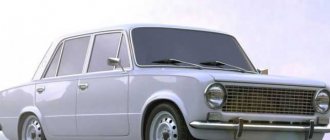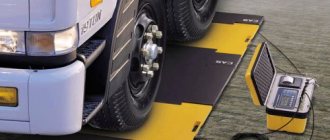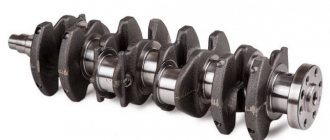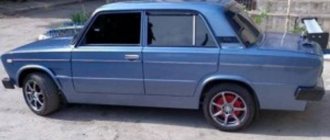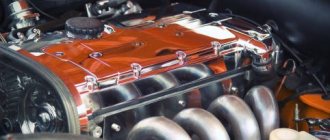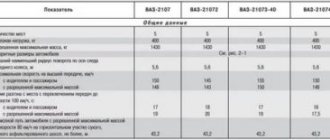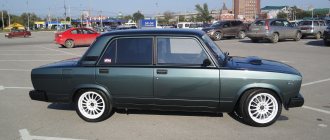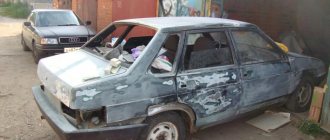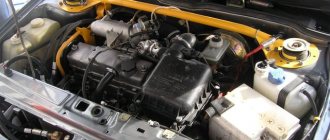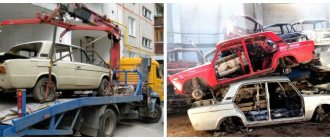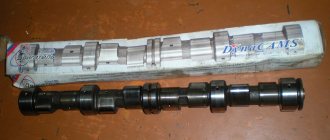VAZ-2104 is the second station wagon belonging to the classic Zhiguli family. An unpretentious, and most importantly, quite roomy car, it appealed to many Soviet car enthusiasts, especially those who, for one reason or another, often had to transport bulky cargo. However, in the USSR they often did not pay attention to the body type - the main thing was to purchase the coveted car. However, even taking into account this circumstance, the “four” should still be distinguished among all products of the Soviet automobile industry.
Model review: VAZ without embellishment
Few people know that the VAZ 2104 (“four”) also bears the foreign name Lada Nova Break. This is a five-seater station wagon, which belongs to the second generation of AvtoVAZ “classics”.
The first models left the factory in September 1984 and thereby replaced the first generation station wagon - VAZ 2102. Although for another year (until 1985) the Volzhsky Automobile Plant produced both models simultaneously.
"Four" - the first station wagon in the VAZ line
VAZ 2104 cars were created on the basis of the VAZ 2105, only they had significant differences:
- extended rear part;
- folding rear bench;
- increased gas tank up to 45 liters;
- rear wipers with washer.
It must be said that the “four” were actively exported to other countries. In total, 1,142,000 VAZ 2104 units were produced.
Along with the VAZ 2104, its modification was also produced - the VAZ 21043. This is a more powerful car with a 1.5 liter carburetor engine and a five-speed gearbox.
Video: review of the Quartet
This is interesting: How much does a gas 53 dump truck weigh?
Diesel modification [edit | edit code]
In 1999, a modification of the VAZ 21045
with a VAZ-341 diesel engine produced by Barnaultransmash with a volume of 1.52 liters and a Bosch injection pump.
Since 2005, it was planned to install a more powerful version of a 1.8-liter diesel engine (modification of the VAZ-21048
), but these plans remained unrealized [4].
The diesel modification was distinguished by a significantly higher cost and lower power of the power plant, despite the fact that in these years diesel fuel was noticeably cheaper than gasoline, the economic feasibility of purchasing this version was in doubt [ source not specified 1381 days
] .
In 2004, production of the VAZ-21045 was discontinued; the remaining unspecified diesel engines in the amount of 500 pieces were completed in a batch of the new modification of the VAZ-21055 [5].
Our blog
Automotive compressors - what are they and how do they work?
Traveling by car always carries risks. And we are talking not only about the serious danger of getting into an accident, but also about minor troubles, such as a broken tire. Many drivers do not go on a long journey if the car does not have a special device for inflating wheels - a compressor. You need to understand what types of car compressors there are, how they work, and why you need to keep such a device in the trunk. Today we will try to cover all the features of operation, selection of a car compressor, and also tell you why you should go to a car store today if you don’t have such a device in your car.
Let's start with the fact that there are several types of pumps. Old manual models are not suitable for cars at all. They create too little pressure and do not allow the tire to be filled with air sufficiently. They are only suitable for bicycles. Foot-based options are more suitable, but are still inaccurate and force the motorist to use his foot for quite a long time before making a safe trip. And the third type is devices that have an autonomous pump-compressor and perform the work without your personal participation. It is enough to connect the device to the battery or cigarette lighter for the equipment to start pumping the wheel.
Read more
How to inflate a tire in a car if there is no pump?
Read more
What to do if you fall into an open hatch or a large hole on the road?
Read more
Changes to OSAGO dated May 25, 2022 – what changes and when?
Read more
All news
One of the undoubted advantages of the VAZ-2104 was its decent trunk volume.
One of the main parameters for station wagon cars is their spaciousness and carrying capacity. The Quartet is no exception to the general rules here. Many car enthusiasts were ready to accept minimal comfort and, in fact, Spartan conditions, just to be able to transport as much cargo as possible.
Let's look at specific numbers. All modifications of the Quartet have a luggage compartment volume of 375 liters. However, everyone probably knows that this figure can be increased by folding the rear seats. A few simple movements, and the luggage compartment volume is already 1,340 liters. In other words, you can place some bulky cargo there without any problems. At the same time, the back of the rear seat, unlike foreign cars, folds completely. This is not always very convenient, but VAZ engineers considered this option more feasible from an economic point of view. It turns out that the convenience of car owners was sacrificed for lower production costs - an approach quite typical for the Soviet automobile industry.
Body
| Number of doors | 5 |
| Number of seats | 5 |
| Wheelbase | 2424 mm |
| Front track | 1365 mm |
| Rear track | 1321 mm |
| Ground clearance | 170 mm |
| Trunk volume is minimal | 345 l |
| Maximum trunk volume | 1340 l |
| Width | 1620 mm |
| Length | 4115 mm |
| Height | 1443 mm |
Delivery of goods to the population
The fifth door of the “ten” is probably its most unfortunate place. On our sample, it closed only after three to five strong claps, and sometimes it opened only after the second press of the remote trunk release button. Do you think it can be adjusted and used for health? Does not work. From the experience of using other VAZ-2111s, we know that adjusting the fifth door lock can alleviate the suffering of this body part (and the owner of the car), but not eliminate it.
And also, I’ll tell you a secret, the author did not have enough strength to recline the right (smaller) part of the rear seat back in the same “eleventh”. A stronger (about 130 kilograms) comrade helped. So that I wouldn’t get upset, he explained that the point was that I didn’t have a solid skill. They say, I don’t know in which direction it needs to be rocked, but he knows. True, he still agreed that cars couldn’t be made that way.
In the “four”, everything is in order with the fifth door, and the seat folds easily. Just to fold the backrest alone, you will have to walk twice from its right latch to the left. If we take for granted the continuous backrest of the rear seat, the VAZ-2104 still wins as a truck. But it’s worth picking up a tape measure.
The distance from the trunk floor to the shelf in the “eleventh” is 50 cm, in the “four” – only 40. From the fifth door to the folded seat, respectively, 160 and 145 cm. The maximum size of the luggage compartment diagonally on the floor is 200 and 180. In general, no matter where you place the tape measure, you will find more in the station wagon of the “tenth” family. We even decided to determine the maximum size of the cabin diagonally and from bottom to top, as if we were going to drive a lining. And here 2111 has an advantage - 280 cm versus 270.
Vehicle interior
The original interior of the VAZ 2104 has an ascetic design. All devices, parts and products are designed to perform their functions; there are no decorations or even a hint of any design solution. The task of the model's designers was to make a working car, suitable for passenger and cargo transportation, without focusing on comfort and beauty.
The interior contains the minimum necessary set of instruments and vehicle controls, standard upholstery in wear-resistant fabric and removable faux leather headrests on the seats. The picture is complemented by standard rubber mats on the floor.
The design of the Four's interior was borrowed from the base model, with the exception of the rear sofa, which was made foldable for the first time in the history of VAZ models.
Video: review of the Quartet’s interior
VAZ 2104 cars were discontinued in 2012. Therefore, even today you can meet amateurs who do not change their beliefs and use only time-tested and road-tested domestic cars.
Copywriter, needlewoman, traveler
(2 votes, average: 3 out of 5)
This is interesting: How to properly apply tint to a windshield
What is the volume of the VAZ-2104 trunk in liters
VAZ-2104 is the second station wagon belonging to the classic Zhiguli family. An unpretentious, and most importantly, quite roomy car, it appealed to many Soviet car enthusiasts, especially those who, for one reason or another, often had to transport bulky cargo. However, in the USSR they often did not pay attention to the body type - the main thing was to purchase the coveted car. However, even taking into account this circumstance, the “four” should still be distinguished among all products of the Soviet automobile industry.
Engine
| Engine capacity | 1450 cm3 |
| Power | 75 hp |
| At rpm | 5600 |
| Torque | 104/3400 n*m |
| Gas distribution mechanism | OHC |
| Number of cylinders | 4 |
| Number of valves per cylinder | 2 |
| Cylinder diameter | 76 mm |
| Piston stroke | 80 mm |
| Compression ratio | 8.5 |
Like God a turtle
Assembling cars can truly work wonders - both literally and figuratively. In direct terms, this is when, communicating, for example, with a simple Matiz, you cannot understand why you like it. Miracles in a figurative sense - on the contrary, when, having driven a modern domestic car, which has a good maximum speed, low fuel consumption, and the climate is controlled by an SAUO computer, you still want to call it Soviet.
And yet the greatest miracles await in a car built to be cheap. You lift the trunk floor covering and stains of rust are visible on the fresh paint that still smells like a conveyor belt. You open the driver's door and see a deep mark on the center pillar that some screw at the end of the door has torn through the metal. When you hang the car on a lift, you immediately see what’s in it. There are drops of antifreeze on the stabilizer mount, and oil drops on the clutch housing. Here is a black spot on the resonator tube - this is the “cut” of the exhaust. Here the muffler bracket hits the body.
The reader decided that we clearly sympathize with the VAZ-2111 - it didn’t happen at all! The copy we received had great difficulty in engaging first gear, and reluctantly in second and third. One of the possible reasons is carelessly assembled rods between the gearbox and the gearshift lever. At least, an inspection in the pit showed that their connecting clamps were bent, and the reaction rod was generally hanging out in the front bracket.
It turns out that the more you learn about cars, the less you want to answer the question...
Performance indicators
| Maximum speed | 143 km/h |
| Acceleration time (0-100 km/h) | 17 s |
| Fuel consumption in the city per 100 km | 10.3 l |
| Fuel consumption on the highway per 100 km | 7.4 l |
| Combined fuel consumption per 100 km | 9 l |
| Fuel tank volume | 45 l |
| Vehicle curb weight | 1050 kg |
| Permissible gross weight | 1475 kg |
| Tire size | 175/70 SR13 |
We are drivers
Let’s not lie - the “classic” is not a competitor to the “ten” in terms of handling, even to the station wagon. But even with the archaic suspension of the Zhiguli, it is possible to achieve acceptable behavior of the car on the road, if everything in it is functional and properly configured.
When two cars drive behind each other in the same mode, you notice the first strange thing in the behavior of the “four” – the setting of its shock absorbers. Contrary to modern ideas about controllability, they begin to work only when the wheels move quickly. No - they react to hitting potholes or strong body rolls in turns, but the subtle movements of the steering wheel, which the driver usually uses to keep the car on a given path, are almost completely ignored.
Undoubtedly, the lack of a clear response to subtle control inputs is a problem not only with shock absorbers. Play in the steering, even small, contributes. It can also be treated by timely adjustment of the steering mechanism and installation of a less pliable pendulum lever. These are sold in stores and are even in demand, but, as far as we know, they do not end up on the production line.
Let's not forget the silent blocks - the performance of the suspension directly depends on their condition and quality. Try asking the salesperson at a car dealership which ones are “the best”. An honest person will first answer you that there are no “best” ones, and only then will he begin to recommend something.
Are we getting carried away? Sorry. Please do not judge strictly - I am ready to explain the reason for this lyrical digression. One of our colleagues (a person with extensive experience) was shocked by the controllability of the “four” that came to us for testing. Since he had his own “classic”, it turns out that a lot has changed in these cars. And not for the better. What is the “eleventh”?
It’s annoying in a new car, especially not the cheapest one, to hear crickets in the right door and the constant creaking of the rear parcel shelf. The adjustment range of the right mirror was too small or too biased towards the driver. In the extreme “far” position, the starboard side is clearly visible in the mirror, and in order to assess whether it is possible to change lanes to the right, you have to lean your whole body.
The design features of the car are such that its response to turning the steering wheel depends too much on the speed of the maneuver. A small amplitude, but fast movement of the steering wheel when going around an obstacle here reaches the wheels with a great delay or does not reach it at all - as if it is stuck somewhere.
In general, the “eleventh” is more strict and precise in control, less lax and not so “independent”. Landing in it is much more comfortable. However, let's say a kind word about the Quartet. For example, on a bad road you don’t feel so sorry for it – against the general noise background, the suspension doesn’t seem to “thump” much. And also, with the kind of mirrors that the dealer installed on our car, visibility became simply excellent (when will the factory bother about this?).
However, it's time to move on to the next comparison indicator.
Skoda Kodiaq
Good afternoon! I am writing my personal opinion about the Skoda Kodiaq, on which I have already driven more than 27 thousand km. So.
Dealer news:
New cars and used cars - tens of thousands of ads for sale. Reviews from car owners. Technical characteristics and accessories. Comparison of models and Test Drives. News from the world of cars. Prices for new cars. Promotions and special offers from car dealerships. We will help you make your choice!
This site is for informational and reference purposes only and under no circumstances constitutes a public offer.
Certificate of registration of mass media EL No. FS77-68106 dated December 21, 2016. Issued by the Federal Service for Supervision of Communications, Information Technologies and Mass Communications. 16+
Interior
The interior has also been completely changed compared to the previous station wagon. The interior was installed from 2105 - new door cards, seats, dashboard. The luggage space was now separated not only by the back of the rear seat - now there was a shelf installed there, similar to hatchbacks.
| Type | Volume | Power | Torque | Overclocking | Maximum speed | Number of cylinders |
| Petrol | 1.5 l | 53 hp | 96 H*m | 23 sec. | 125 km/h | 4 |
| Petrol | 1.2 l | 58 hp | 84 H*m | 18 sec. | 140 km/h | 4 |
| Petrol | 1.3 l | 64 hp | 92 H*m | 18 sec. | 137 km/h | 4 |
| Petrol | 1.5 l | 71 hp | 104 H*m | 17 sec. | 143 km/h | 4 |
| Petrol | 1.6 l | 74 hp | 116 H*m | 17 sec. | 145 km/h | 4 |
Many power units were installed on the car. At the beginning of production, engines familiar to many were installed: “three”, 1.5 liter, 77 hp. and, new at that time, a VAZ 2105 rotary engine with a volume of 1.3 liters. Later versions were equipped with VAZ 21067 and 21073 injection engines, 1.6 and 1.7 liters, and even a VAZ diesel engine. It was combined with a classic 4-speed "", and later versions with a 5-speed. It’s interesting that the car was equipped with a “sedan” main pair 3.9, or a 4.1 different from 2102.
Suspension
The suspension was inherited from its predecessor - a reinforced classic one. Namely, the front is independent, on levers with springs, and the rear is dependent, also with springs.
Since they were discontinued late, many cars remain in excellent condition today. Although, it is worth recognizing that the quality of the latest cars is much worse than the cars of that era. VAZ 2104 was exported under the name Lada Riva. There were also right-hand drive versions. Export cars were equipped with a speedometer graduated in miles. The Quartet has become perhaps the most popular domestic station wagon. It is actively used by Russian Post, having the appropriate coloring and a white-moon beacon on the roof.
Specifications
A car in a station wagon weighs a little, only 1020 kg (for comparison: the “five” and “six” in a sedan body weigh more - from 1025 kg). The dimensions of the VAZ 2104, regardless of the configuration, are always the same:
- length - 4115 mm;
- width - 1620 mm;
- height - 1443 mm.
Thanks to the folding rear row, the trunk volume can be increased from 375 to 1340 liters, which made it possible to use the car for private transportation, country work and even small businesses. However, the back of the rear sofa does not fold entirely (due to the specific design of the car), so it is impossible to transport long cargo.
However, long elements are easy to fix on the roof of the car, since the length of the VAZ 2104 allows you to transport beams, skis, boards and other long items without the risk of creating dangerous road situations. But you cannot overload the roof of the car, since the calculated rigidity of the station wagon body is much lower than that of sedans of the next generations of VAZ.
The total load on the vehicle (passengers + cargo) should not exceed 455 kg, otherwise damage to the chassis may occur.
The “Four” was equipped with two types of drives:
- FR (rear-wheel drive) is the basic equipment of the VAZ 2104. Allows you to make the car more powerful.
- FF (front-wheel drive) - selected models were equipped with front-wheel drive, as it is considered safer; subsequent versions of the VAZ began to be produced only in front-wheel drive.
Like other Lada representatives, the Four has a ground clearance of 170 mm. Even today, this is a completely reasonable ground clearance, allowing you to overcome major road obstacles.
Engine characteristics
Over the years, the VAZ 2104 was equipped with power units of different power: from 53 to 74 horsepower (1.3, 1.5, 1.6 and 1.8 liters). Two modifications (21048D and 21045D) used diesel fuel, but all other versions of the “four” consumed AI-92 gasoline.
Depending on the engine power, fuel consumption also varies.
Table: average fuel consumption per 100 km
The VAZ 2104 accelerates to a speed of 100 km/h in 17 seconds (this is a standard indicator for all VAZs produced in the 1980–1990s). The maximum speed of the machine (according to the operating instructions) is 137 km/h.
Table: parameters of the “four” motor
| Number of cylinders: | 4 |
| Cylinder displacement, l: | 1,45 |
| Compression ratio: | 8,5 |
| Rated engine power at a crankshaft speed of 5000 rpm: | 50.0 kW.- (68.0 hp) |
| Cylinder diameter, mm: | 76 |
| Piston stroke, mm: | 80 |
| Number of valves: | 8 |
| Minimum crankshaft rotation speed, rpm: | 820–880 |
| Maximum torque at 4100 rpm, N*m: | 112 |
| Cylinder operating order: | 1–3-4–2 |
| Octane number of gasoline: | 95 (unleaded) |
| Fuel supply system: | Electronically controlled distributed injection |
| Spark plug: | А17ДВРМ, LR15YC-1 |
